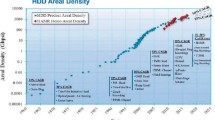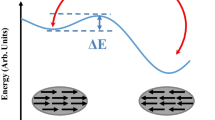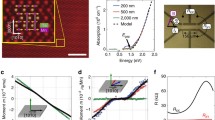Abstract
We have carried out a combined experimental and computer simulation study to specify and identify candidate films to support high areal density, thermally-assisted magnetic recording. The motivation of this work is to utilize the enhanced writability of very high coercivity materials that thermal assistance can provide. Media with high coercivity (and anisotropy Ku) are known to be essential to achieve a sufficiently high ratio of KuV/kBT necessary to maintain magnetic stability at temperature T in media switching units (grains; single domains) of volume V. Nominally, we expect V ∝ D−3/2, where D is the medium bit density per unit area in recording. A micromagnetic recording simulation tool with a capability of representing realistic grain size distributions, temperature-dependent magnetic properties, and spatially-varying imposed temperature distributions was employed to study the interplay of thermal and magnetic field gradients in the recording process. In addition, a simple LLG-based thermomagnetic switching model supplemented the micromagnetics model. We fabricated improved Co/X multilayer media for recording evaluation, and performed standard materials characterization.
Similar content being viewed by others
References
Dieter Weller and Andreas Moser, IEEE Trans. Magn. 35, 4423 (1999).
S.H. Charap, Pu-Ling Lu, and Yanjun He, IEEE Trans. Magn. 33, 978 (1997).
Roger Wood, IEEE Trans. Magn. 36, 36 (2000).
D. Weller, et al, IEEE Trans. Magn. 36, 10 (2000).
H. Saga, et al, Proc. MORIS 1999, J. Magn. Soc. Jpn. 23, Suppl. S1, 225 (1999); Nemoto et al, ibid, p.229; H. Katayama, et al, ibid, p.233 (1999)
H. Katayama, et al, IEEE Trans. Magn. 36, 195 (2000).
Wenbin Peng, et al, Intermag Conference 2000, to be published in IEEE Trans. Magn.
H.N. Bertram and M. Williams, IEEE Trans. Magn. 36, 4 (2000).
T.W. McDaniel, J. Magn. Soc. Jpn. 23, Suppl. No. S1, 251 (1999).
M. Alex, A. Tselikov, T. McDaniel, N. Deeman, T. Valet, and D. Chen, Intermag Conference 2001 paper HC-01, to be published in IEEE Trans. Magn.
Euxine Technologies, Advanced Recording Model (ARM), Broomfield, CO 80020 USA
Jaap J.M. Ruigrok, Proc. MORIS / APDSC 2000, Nagoya, Japan; to be published in J. Magn. Soc. Japan.
Kazuhiro Ouchi and Naoki Honda, IEEE Trans. Magn. 36, 16 (2000).
M. Alex, T. Valet, T. McDaniel, and C. Brucker, MORIS / APDSC 2000, Nagoya, Japan; to be published in J. Magn. Soc. Jpn.
C. Brucker, “Magneto-Optical Thin Film Recording Materials in Practice, ” Handbook of Magneto- Optical Data Recording, ed. T.W. McDaniel and R.H. Victora, (Noyes, 1997) pp. 279–361.
K.B. Klaassen and J.C.L. van Peppen, Intermag Conference 2001 paper EA-06, to be published in IEEE Trans. Magn.
Author information
Authors and Affiliations
Rights and permissions
About this article
Cite this article
Brucker, C.F., McDaniel, T.W. Materials Development for Thermally-Assisted Magnetic Recording Media. MRS Online Proceedings Library 674, 23 (2001). https://doi.org/10.1557/PROC-674-V2.3
Published:
DOI: https://doi.org/10.1557/PROC-674-V2.3




